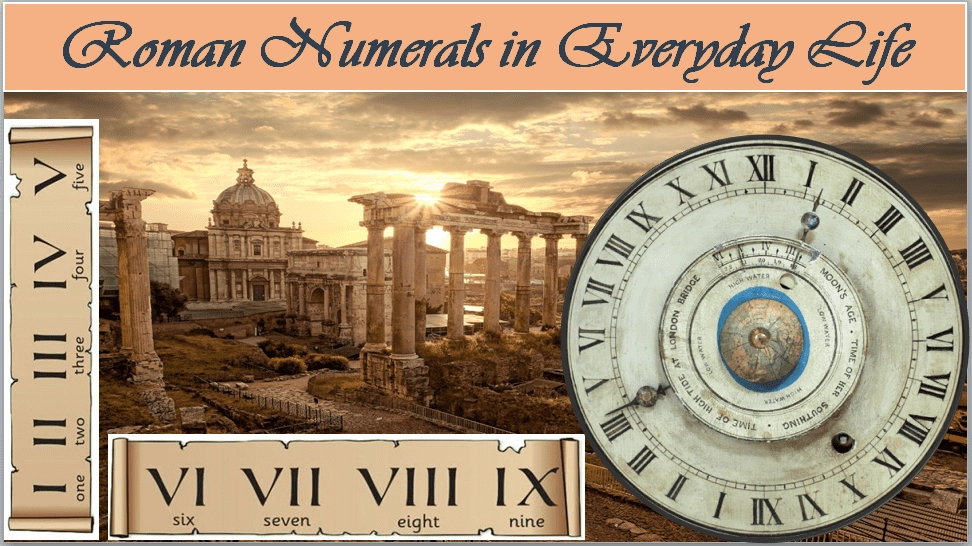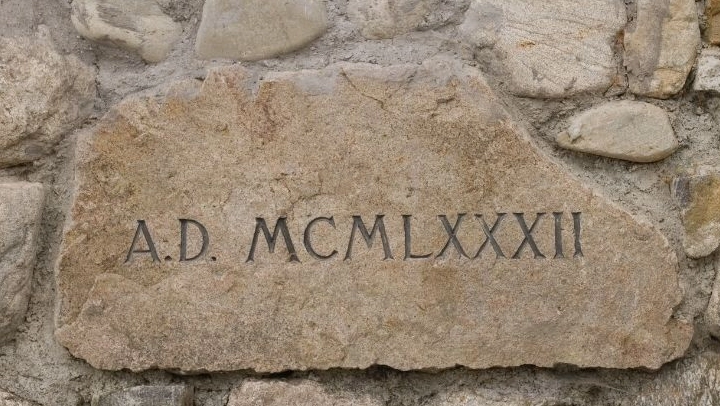In the tapestry of human history, Roman numerals stand as enduring symbols, weaving a thread that connects ancient civilizations to the present day.
These enigmatic symbols (roman letters for numbers), with their unique charm and historical resonance, have found a place in the annals of time and our day-to-day lives.
They play a small yet meaningful role in modern times, showcasing the rich history and enduring legacy of the Roman Empire. This blog explores the Roman letters for numbers and unravels their intriguing history.
- A Brief History and Origin
- Conclusion
- FAQs
- 1. What are the origins of Roman numerals and why are they still used today?
- 2. How do you read and write Roman numerals?
- 3. How is the number 900 expressed in Roman numerals, and what do the symbols represent?
- 4. Explain the Roman numeral representation for 500 and how it differs from 400?
- 5. How is the number 1000 expressed in Roman numerals, and what does the symbol "M" signify?
A Brief History and Origin

The origins of Roman numerals stem from the Etruscans, an ancient civilization that preceded the Roman Empire. (Emerged around 8th-9th century BC from the Etruscan system, possibly inspired by tally sticks or hand signals.) The Etruscans used the symbol I for one and V for five.

As the ancient Romans adopted this system, they introduced additional symbols up to M for 1000, combining them in various ways to form larger numbers. The basic symbols used in this system are I, V, X, L, C, D, and M, each with its unique value.
1 | 5 | 10 | 50 | 100 | 500 | 1000 |
I | V | X | L | C | D | M |
The Roman numeral system, including examples of Roman numerals and the subtractive principle, was widely used in ancient Rome and is still used today in various applications, such as marking the hours on a clock face or representing the Super Bowl number in a unique way and efficient way.
1. Roman Letters for Numbers
The system of numerical notation, known as Roman numerals, is a combination of letters from the Latin alphabet, and each letter represents a different value.

The system of Roman numerals, which is a unique and fascinating numerical system with its own set of rules and conventions, was gradually replaced by Arabic numerals from the 14th century onwards.
2. Understanding the Basics
The order of the numerals expresses their value - The letter "I" always stands for the number 1. In the same way, II is two (1+1), while VI is six (5+1).
I = 1 | VI = (5+1) = 6 |
II = (1+1) = 2 | VII = (5+1+1) = 7 |
III = (1+1+1) = 3 | VIII= (5+1+1+1) = 8 |
IV = (1+1+1+1) = 4 (I before V means subtract 1 from 5) | IX = 9 (I before X means subtract 1 from 10) |
V = 5 | X = 10 The Romans developed a counting system based on seven symbols: |
The Romans developed a counting system based on seven symbols: I, V, X, L, C, D, and M, representing 1, 5, 10, 50, 100, 500, and 1000, respectively.
The number 0 does not exist in the Roman system.
3. Roman Symbols and Their Interpretation
I | 1 | The foundational symbol, representing the unity of a single unit. |
V | 5 | Derived from the Latin word "quinque," this symbol signifies the number five. It is a unique representation of half the value of X. |
X | 10 | A versatile symbol representing ten, it is formed by combining two V's. The concept of counting in tens greatly influenced the adoption of this symbol. |
L | 50 | With its distinctive loop, L symbolizes fifty, forming a bridge between the tens and hundreds. |
C | 100 | Evolving from the Latin word "centum," C represents one hundred and is a cornerstone of the Roman numeral system. |
D | 500 | The symbol D, originating from "quingenti" in Latin, embodies the numerical value of five hundred. |
M | 1000 | The grandest symbol in the Roman numeral lexicon, M signifies one thousand, offering a glimpse into the vastness of Roman numerical reckoning. |
4. The placement of Roman Numerals and Modern Numbers
Roman Numerals
Additive system: Symbols are added together with increasing value from left to right.
Example
XII = I + I + I + I + I + I + I + I + I + I + I + I
Subtractive rule: In specific cases, a smaller symbol can be placed before a larger one to subtract its value.
IV represents 5 - 1 = 4 IX represents 10 - 1 = 9 XL represents 50 - 10 = 40 XC represents 100 - 10 = 90 CD represents 500 - 100 = 400 CM represents 1000 - 100 = 900
Repetition limits: No symbol can be repeated more than three times consecutively. For larger values, combinations of symbols are used Example:
VI for 6, not IIII
Units | Tens | Hundreds | Thousands |
I | X | C | M |
II | XX | CC | MM |
III | XXX | CCC | MMM |
Modern Numbers
Place value system: The value of a digit depends on its position within the number. Tens place, hundreds place, and so on, hold increasing multiplied values as we move left.
For example, in 123, the 1 is in the hundreds place (1 x 100), the 2 is in the tens place (2 x 10), and the 3 is in the ones place.
Unlimited repetition: Each digit can be repeated any number of times, allowing for efficient representation of large numbers.
5. Hundreds
Fifties and Tens
The other letters allow you to count into the thousands by representing increasing scales of 10. So once you reach 10 "X"'s, you write C for 100.
X | XX | XXX | XL | L | LX | LXX | LXXX | XC | C |
10 | 20 | 30 | 40 | 50 | 60 | 70 | 80 | 90 | 100 As we venture into the hundreds, the Roman numeral system becomes even more interesting. Counting from 1 to 100 in Roman numerals involves using combinations like |
As we venture into the hundreds, the Roman numeral system becomes even more interesting. Counting from 1 to 100 in Roman numerals involves using combinations like XL (40), L (50), LX (60), LXX (70), LXXX (80), XC (90), and C (100).
6. Putting Them Together
To 1000 By continuing this pattern of slots up to thousands, you can count up to the Roman numeral M, which stands for 1000.
100 | 200 | 300 | 400 | 500 |
C | CC | CCC | CD | D |
600 | 700 | 800 | 900 | 1000 |
DC | DCC | DCCC | CM | M Beyond this point, Roman numerals continue to increase in thousands, creating symbols like |
Beyond this point, Roman numerals continue to increase in thousands, creating symbols like MM (2000) and MMM (3000).
I = 1 | X= 10 | C = 100 | M=1000 |
II= 1 + 1 = 2 | XX = 10 + 10 = 20 | CC = 100 + 100 = 200 | MM= 1000+1000 = 2000 |
III = 1 + 1 + 1 = 3 | XXX = 10 + 10 + 10 = 30 | CCC = 100 + 100 + 100 = 300 | MMM= 1000 + 1000 + 1000 = 3000 |
https://www.youtube.com/embed/RkoTeO-7aiE Steps to Write Roman Numerals
Understand the basic symbols I, V, X, L, C, D, and M, each with its unique value.
Learn all of the digits in ones place.
Learn all of the digits in the tens place.
Learn all of the digits in the hundreds place.
Know that you can’t have more than three of the same symbol in a row. When you place the same symbols together, you can just add their values. Normally the maximum number of the consecutive same symbols is three.
Add smaller symbol values that are placed after large symbol values. Similar to the above rule, just add their values together. Remember the numeral must have the larger symbol value first for this to work.
Subtract smaller symbol values that are placed before larger symbol values. In this case, you need to subtract the smaller value from the larger value.
Know how compound numbers are written. There are numerous rules that govern the way Roman numerals are supposed to look.
Learn to write larger numbers.
Examples
1) Convert 2987 to Roman number:2987
Is written as MMCMLXXXVII because: The first M gives you 1000 The next M gives you 1000 The next CM gives you 900 The next LXXX gives you 80 The next VII gives you 7 Therefore, if you add the amounts together, you will get 2987.
Roman number: CDLIX Explanation
C = 100
D = 500
L = 50
IX = 10 - 1 = 9
Combine the values: 500 + 100 + 50 + 9 = 659
Roman number: DCCCXXXI Explanation
D = 500 (repeated twice, so 500 x 2 = 1000)
CCC = 100 x 3 = 300
XXXI = 10 + 10 + 10 + 1 = 31
Combine the values: 1000 + 300 + 31 = 1331
Roman number: MMDIV: Explanation
MM = 1000 x 2 = 2000
D = 500
IV = 5 - 1 = 4
Combine the values: 2000 + 500 + 4 = 2504
Interesting Facts
1) No Zero: One notable absence in Roman numerals is the concept of zero, a mathematical innovation that emerged later in different numeral systems.
2) Limited Calculations: Roman numerals were primarily used for counting and basic calculations. Complex mathematical operations were challenging due to the absence of a positional system.
3) Clock Faces: Roman numerals often grace clock faces, lending a touch of timeless elegance to timekeeping. Clocks featuring Roman numerals evoke a sense of tradition and sophistication.

4) Numerals in Modern Society: Roman numerals persist in contemporary society, adorning book prefaces, movie credits, and indicating the numbering of monarchs and popes.
5) Titles and Names: Roman numerals add a touch of formality and tradition to titles of monarchs (Queen Elizabeth II), awards (Super Bowl LIV), and chapters in books or plays.
6) Military Unit Designations: Roman numerals differentiate between units at different levels, avoiding confusion on maps.
7) Roman numerals have played a significant role in history, and their uses can be found in various aspects of ancient and modern culture.



Conclusion
Roman numerals may seem quaint in our age of calculators, but they offer a glimpse into the ingenuity of ancient civilizations, ancient Roman culture.
While Arabic numbers dominate most math and statistics, Roman numerals, including the history and use of Roman numerals, still influence how we communicate dates, sequences, and classifications in the modern world.
These relics of ancient Rome, including the use of Roman numerals, add texture to our daily lives by linking modern society to the rich legacy of the classical world.
Their longevity is a testament to the cleverness and creativity of early Roman civilization. Understanding the history and use of Roman numerals can enrich your appreciation for history, architecture, and art.
So, explore and conquer the ancient art of counting like a Roman! Learn more about exclusive mathematics classes and learn more exciting facts about numerals!
FAQs
1. What are the origins of Roman numerals and why are they still used today?
Roman numerals originated in ancient Rome and were used in various aspects of Roman society, such as numbering books, marking years, and identifying rulers. Today, they are still used in certain contexts like clock faces, movie credits, and book chapters to convey a sense of tradition and sophistication.
2. How do you read and write Roman numerals?
Roman numerals are read by adding the values of each symbol together. The symbols are written in a specific order, with larger values always in front of smaller values. To write Roman numerals, you simply combine the appropriate symbols in the correct order to represent the desired value.
3. How is the number 900 expressed in Roman numerals, and what do the symbols represent?
The number 900 is expressed in Roman numerals as CM. Here, "C" represents 100, and "M" represents 1000. So, CM is formed by subtracting 100 from 1000, resulting in 1000 - 100 = 900.
4. Explain the Roman numeral representation for 500 and how it differs from 400?
The Roman numeral for 500 is D. In contrast, CD represents 400. The key difference is that in 400 (CD), the smaller numeral "C" (100) is placed before the larger "D" (500), indicating subtraction, resulting in 500 - 100 = 400.
5. How is the number 1000 expressed in Roman numerals, and what does the symbol "M" signify?
The number 1000 is expressed in Roman numerals as M. The symbol "M" stands for 1000. Unlike other combinations involving subtraction, "M" represents the total value of 1000 in the Roman numeral system.


Comments